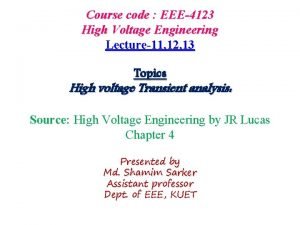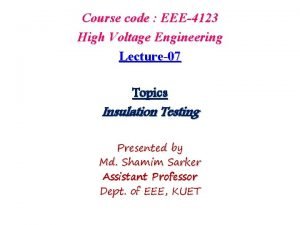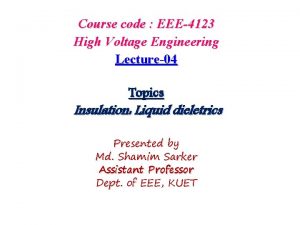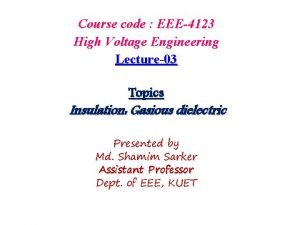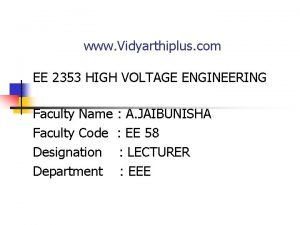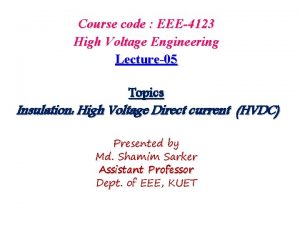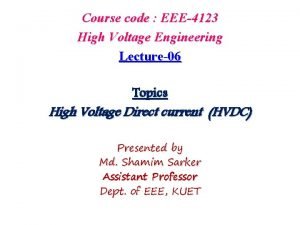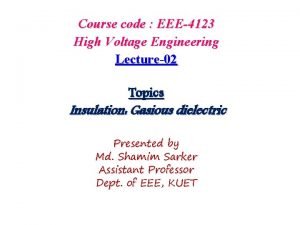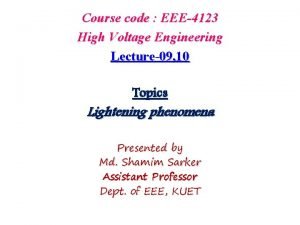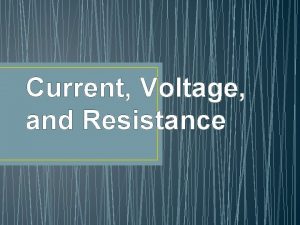Course code EEE4123 High Voltage Engineering Lecture07 Topics













- Slides: 13

Course code : EEE-4123 High Voltage Engineering Lecture-07 Topics Insulation Testing Presented by Md. Shamim Sarker Assistant Professor Dept. of EEE, KUET

General tests carried out on High voltage equipment 1. Sustained low-frequency tests: (i) Sustained low frequency tests are done at power frequency (50 Hz) (ii) Tests are made upon specimens of insulation materials for the determination of dielectric strength and dielectric loss, for routine testing of supply mains, and for work tests on high voltage transformers, porcelain insulators and other apparatus. Devices are subjected to a voltage of = 1 k. V + 2 × (working voltage). A 230 V piece of equipment may thus be subjected to about 1. 5 to 2 k. V.

2. High Voltage direct current tests: (i) These tests are done on apparatus expected to operate under direct voltage conditions (ii) Also where, due to the inconvenience of the use of high capacity transformers required for extra high tension alternating voltage tests and due to transport difficulties, alternating voltage tests cannot be performed after installation. 3. High-frequency tests (i)High frequency tests at frequencies varying from several k. Hz are important where there is a possibility of high voltage in the lines (ii) In insulators which are expected to carry high frequency such as radio transmitting stations. (iv) It is also found that high frequency oscillations cause failure of insulation at a comparatively low voltage due to high dielectric loss and heating. 4. Impulse test & 5. Flash-over test

High voltage testing can be broadly classified into: 1. Testing of insulating materials (samples of dielectrics) 2. Tests on completed equipment The tests on insulators can be divided into three groups: (i) Type tests (ii) Sample tests (iii) Routine tests

Test on Insulator Type Test: These tests are done to determine whether the particular design is suitable for the purpose. Withstand Test: A 1/50 s wave of the specified voltage. is applied. Flashover or puncture should not occur. The test is repeated five times for each polarity. Flash-over test: A 1/50 s wave is applied. The voltage is gradually increased to the 50% impulse flashover voltage. The test is done for both polarities. There should be no puncture of insulation during these tests.

Dry One-minute test: The insulator, clean and dry, shall be mounted as specified and the prescribed voltage should be gradually brought up (at power frequency) and maintained for one minute. Thee shall not be puncture or flash-over during the test. Dry flash-over test: The voltage shall then be increased gradually until flash-over occurs. This is repeated ten times. There shall be no damage to the insulator. One-minute Rain test: The insulator is sprayed throughout the test with artificial rain drawn from a source of supply at a temperature within 10 degree Celsius of the ambient temperature of the neighborhood of the insulator. The rain is sprayed at an angle of 45 degree on the insulator at the prescribed rate of 3 mm/minute. The prescribed voltage is maintained for one minute. Wet flash-over test: The voltage shall then be increased gradually until flash-over occurs. This is repeated ten times. There shall be no damage to the insulator.

Visible discharge test: This states that after the room has been darkened and the specified test voltage applied, after five minutes, there should be no visible signs of corona.

Sample Test: The sample is tested fully, up to and including the point of breakdown. This is done only on a few samples of the insulator. Temperature cycle test: The complete test shall consist of five transfers (hot-cold-hot-. . ), each transfer not exceeding 30 s. Mechanical loading test: The insulator shall be mechanically loaded up to the point of failure. Electro-mechanical test: The insulator is simultaneously subjected to electrical and mechanical stress. (i. e. it shall be subjected to a power frequency voltage and a tensile force simultaneously. The voltage shall be 75% of dry flash-over voltage. There should be no damage caused.

Overvoltage test: The insulator shall be completely immersed in an insulating medium (oil), to prevent external flashover occurring. The specified overvoltage must be reached without puncture. The voltage is then gradually increased until puncture occurs. Porosity test: Freshly broken pieces of porcelain shall show no dye penetration after having been immersed for 24 hours in an alcoholic mixture of fushing at a pressure of 2000 p. s. i.

Routine Tests These are to be applied to all insulators and shall be commenced at a low voltage and shall be increased rapidly until flash-over occurs every few seconds. The voltage shall be maintained at this value for a minimum of five minutes, or if failures occur, for five minutes after the last punctured piece has been removed. At the conclusion of the test the voltage shall be reduced to about one-third of the test voltage before switching off. Mechanical Routine Test: A mechanical load of 20% in excess of the maximum working load of the insulator is applied after suspending the insulator for one minute. There should be no mechanical failure of the insulator.

Test carried out on the sample of dielectrics are: (i) Measurement of the insulation resistance under d. c. voltages. (ii) Determination of loss factor tan δ and the capacitance C. (iii) Measurement of partial discharges. .

Measurement of dc insulation resistance, volume resistance, and surface resistance.

Determination of loss factor tan δ and the capacitance C Example: 6. 1 to 6. 6
 Eee4123
Eee4123 Eee4123
Eee4123 Eee4123
Eee4123 Eee4123
Eee4123 Electric field stress in high voltage engineering
Electric field stress in high voltage engineering Overvoltage due to switching surges
Overvoltage due to switching surges Ee2353 high voltage engineering
Ee2353 high voltage engineering High voltage technology
High voltage technology Ac voltage controller applications
Ac voltage controller applications Phase to phase voltage
Phase to phase voltage Volts to rms
Volts to rms Objectives of earthing
Objectives of earthing Busceral
Busceral Advanced topics in software analysis and testing
Advanced topics in software analysis and testing
